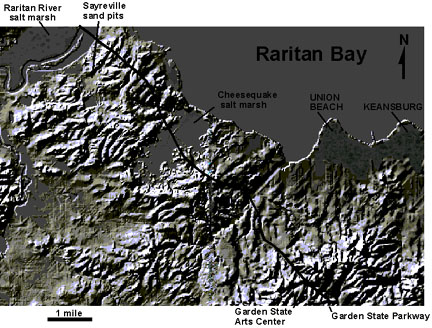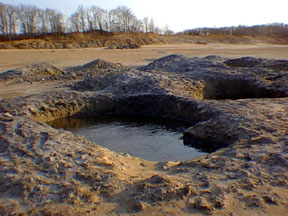49. Sayreville/Kennedy Park
The landscape around Sayreville, New Jersey displays the massive scars from nearly three centuries of mining operations that extracted clays and sands of the Raritan and Magothy Formations. Early in the regions's development, the clays of the Raritan were recognized for their reasonably high quality for firing to make pottery and brick. In addition, the building of the infrastructure of the region required huge quantities of clean quartz sand. The discovery of massive, poorly consolidated deposits of both sand and clay in close proximity to Raritan Bay started an industry. The Sayreville area was transformed into a cratered surface of large sand and clay pits. However, Sayreville wasn't the only place where the Raritan and Magothy were mined; sand pits were also dug into the formations on Staten Island and even in Brooklyn. However, as bridges were built and as suburbia expands, most of these old pits are vanishing beneath new neighborhoods and shopping malls. At different times in the past some of these excavations have yielded interesting fossils and minerals. Of perhaps greatest intrigue is the occurrence of insect-bearing amber from the Raritan Formation. Old timers on Staten Island have told stories about lignite deposits so rich in amber that large chunks "were used for firewood." In any case, lignite does occur in pockets throughout the coastal plain region. During the 19th Century as firewood supplies began to dwindle in the Sayreville area, local lignite was added to charcoal used for brick firing and for generating steam.
Kennedy Park is a partially developed recreational facility within a large sand pit. It adjoins a large semi-active sand mining operation in another pit to the north (Figure 122). Most of the top soil had been stripped away from the area by the mining operations that began long before laws were established to protect and renourish the soil. As a result, most of the park area now consists of barren badlands with a scattering of shrub oak and pitch pines. The deposits exposed are terrestrial to marginal marine in origin. The sands and clays were deposited in stream channels, on coastal river flood plains, or in brackish backwater bays or swamps. At Kennedy Park it is difficult to differentiate between the Raritan and Magothy Formations. This is because the depositional processes responsible for their formation occurred gradually in a variety of coastal sedimentary environments. However, the Raritan is the lower of the two formations, and it occurs throughout the lower areas in the park and in the pits in the surrounding area. In recent years deposits of amber-bearing lignite were discovered in a large sand pit near Kennedy Park, just about the time that the movie "Jurassic Park" hit the theaters. As a result, a very reckless, disorganized mining venture began on land that was under questionable jurisdiction. Scientists, museum curators, amateur collectors, and geology students were hand-digging room-sized holes next to even bigger holes dug by commercial fossil diggers (Figure 123). On a cool weekend day it was not unusual to encounter several dozen people out digging. Invariably, things sometimes turned ugly as innocent curiosity often turned to jealous greed. People actually got hurt. No one in authority ever considered handing out permits; in fact, who was in authority was in question. Every once in a while, locals complained and a bulldozer would be sent out to fill in the holes, or, a torrential rain would come along and flood the holes for weeks. Now new homes cover most of the best localities.
 |
| Figure 122. A shaded relief image (digital elevation model) of the south shore of Raritan Bay in Monmouth County, New Jersey showing the rugged topography of the Atlantic Highlands escarpment. |
 |
| Figure 123. Holes dug by collectors in search of amber in the Sayreville sand pits. Badlands-style erosional topography is forming on the exposed Cretaceous Magothy Formation in the distance. This area is now under a new housing development. |
The amber from New Jersey is not of quality high enough to use as jewelry, however it may be "treated" to look that way. The true value of the amber, and the lignite, is the rich fossil fauna and flora it has yielded. Insects of many varieties, seeds, nuts, and other plant material, including fossil flowers, have been found. Another interesting feature of the deposits is the occurrence of pieces of amber imbedded within large nodules of marcasite and pyrite. Small round balls of pyrite and limonite are exposed along the small rills cut during rain storms. Although the pyrite balls are pretty, they are unstable in the air, and usually crumble upon drying. After a storm it is possible to find small pieces of amber lying on the surface where people have dug; some pieces glow weakly under a black light.
To get to Kennedy Park, take Route 9 south from the tangle of Interstates west of the Outerbridge Crossing. Route 9 parallels the Garden State Parkway over the Raritan River and it joins Route 35 for about two miles. Stay in the right lain on Route 9 when the two roads split. Proceed just over a mile to the Ernston Road Exit. Travel north on Ernston Road, go under the railroad bridge and past a couple of traffic lights; then turn left on Washington Road. The entrance to Kennedy Park is a few hundred feet north of this intersection. Walk all over the outcrops around the border of the park. Amber can usually be found anywhere that there are dark patches of lignite exposed. Keep an eye out for pieces of wood and rare bone. Remember, if signs are posted, keep out unless you have permission. Be aware that any hand dug excavation can be extremely unstable and especially hazardous to children.
| Return to Geology of the Coastal Plain Province. |